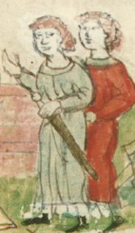List of leaders of Ukraine
This section has multiple issues. Please help improve it or discuss these issues on the talk page. (Learn how and when to remove these messages)
|
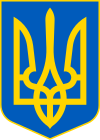 |
|---|
|
|
This is a list that encompasses and includes all leaders and rulers in the history of Ukraine. This page includes the titles of the Grand Prince of Kiev, Grand Prince of Chernigov, Grand Prince of Pereiaslavl, Grand Prince of Galicia–Volhynia, Hetman of Ukraine and President of Ukraine. The following list begins with the leaders who ruled over the territory of Ukraine during Antiquity and is followed by the princes who ruled the principalities that constituted Kievan Rus and continues with the presidents of Ukraine.
The territory has been known by a plethora of names, it has been known historically as: Kievan Rus, Rus', the Kingdom of Galicia-Volhynia, the Zaporozhian Host and the Hetmanate. The sovereigns of these fluctuating political entities have accordingly been described in a variety of ways: knyaz, knyahinya, korol, hetman and president. Two of the earliest noble titles: knyaz and velyky knyaz translate into English as "Prince" and "Grand Prince" respectively, whilst korol translates into 'king'.
The list includes its presidents both before and after the Soviet era, and the Soviet leaders themselves, who, unlike the presidents, were not formal heads of state. Ukraine has had only eight presidents since 1917, divided into two periods (1917–1921 and 1991–present). In between, the country was a part of the Soviet Union (1922–1991) with the name of Ukrainian Soviet Socialist Republic.
Princes of Kiev
[edit]Legendary princes (482–882)
[edit]| Portrait | Name | Born-Died | Ruled From | Ruled Until | Notes |
|---|---|---|---|---|---|
| Kyi | 5th–6th centuries | 482 | ? | A legendary founder of Kiev, a Slavic prince of Kuyavia, most likely eastern Polans | |
| Askold and Dir[1] (Old Norse: Høskuldr and Dýri) |
? – 882 | c. 842[2] | 882 | Probably of Swedish origin, Varangian konungs, not Rurikids, were rulers (khagans) of Kiev, which wasn't yet Kievan Rus'. |
Rurik Dynasty (862–1362)
[edit]
The Rurikids were descendants of Rurik (Ukrainian: Рюрик) (Hrørekr), a Varangian pagan konung or chieftain, who according to the Primary Chronicle was invited to rule Novgorod in 862 and who came to become the ruler of the Northern Slavic tribes of the (Krivchians and Slovene) as well as the Finnish tribes (Meria, Chud and Ves). Later his son or grandson, Prince Ihor, became the Prince of separate Kievan territories to the south beginning the rule of the Riurykide dynasty of Kievan Rus. The existence of Rurik is a point of contention for historians, P. Kovaletsky and Omeljan Pritsak believe that Rurik was the same person as Hroereckr (Rorik), the 9th century Norse king of Jutland and Frisia and that pervasive myths and legends about him formed the basis for the primary chroniclers. Alternatively, Alexsei Shakmatov accepts the Primary Chronicle's account as factual and Rurik is a historic being.[3]
Partitions of Kievan Rus' in Ukrainian territory under Rurik dynasty[4]
| Grand Principality of Rus', Kievan Rus' (862–1132) | ||||
| Principality of Kiev (1132-1301) |
Principality of Chernihiv (1097-1307) |
Principality of Halych (1097–1199) (divided in Terebovlia, Peremyshl and Zvenigorod until 1141) |
Principality of Volhynia (1097–1199) |
Principality of Pereyaslavl (1097–1215) |
| Kingdom of Halych-Volhynia (1199-1345) |
||||
| Annexed to Vladimir-Suzdal | ||||
| Annexed to Lithuania |
Annexed to Lithuania (since 1401) | |||
| Halych to Poland; Volhynia to Lithuania | ||||
(Note: As many princes ruled at different times in many places, the numbering of the princes is restricted to the Kievan Rus'/Kiev and the Kingdom of Galicia-Volhynia)
| Ruler | Born | Reign | Ruling part | Consort | Death | Notes | |
|---|---|---|---|---|---|---|---|
| Rurik I (Рюрик) Old Norse: Rørik |
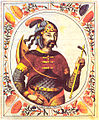
|
Unknown | 862–879 | Kievan Rus' (at Novgorod) |
Unknown at least one son |
879 | Ruled as Prince of Novgorod. Founder of the family. |
| Oleg the Seer (Олег Віщий) Old Norse: Helgi[5] |

|
Unknown | 879–912 | Kievan Rus' | Unknown | 912 | Varangian kniaz of Holmgård (Novgorod) and Kønugård (Kiev). His relationship with the family is unknown. He was probably a regent, in name of Igor, son of Rurik. Oleg extended his rule over the Derevlianians, Siverianians, Radmichians and Polianians. Began campaigns against the Khazars. Proclaimed himself Prince. |
| Igor I the Old Igor Rurikovich (Ігор Старий[6]) Old Norse: Ingvar Röreksson |

|
c.878 Son of Rurik |
912–945 | Kievan Rus' | 901 or 902 at least one son |
945 Iskorosten aged 66–67 |
|
| Saint Olga of Kiev (Свята Ольга) Old Norse: Helga |

|
c.890 Pskov |
945–962 | Kievan Rus' | 11 July 969 Kiev aged 78–79 |
Regent on behalf of her minor son, she was baptized by Emperor Constantine VII but failed to bring Christianity to Kiev. | |
| Sviatoslav I the Brave Sviatoslav Igorevich (Святосла́в Хоро́брий) Old Norse: Sveinald Ingvarsson[7] |

|
c.942 possibly Kiev Son of Igor I the Old and Saint Olga of Kiev |
962 – March 972 | Kievan Rus' | Predslava c.954 two sons Malusha/Malfrida[8][9] c.958 at least one son |
March 972 Khortytsia aged 29–30 |
The first true ruler of Rus' who destroyed the Khazar Khaganate and united all of the Rus' principalities under the Kiev throne. |
| Yaropolk I Yaropolk Sviatoslavich (Яропо́лк Святосла́вич) Old Norse: Iaropolk Sveinaldsson |

|
c.950 Son of Sviatoslav I the Brave and Predslava |
March 972 – 980 | Kievan Rus' | A Greek nun at least one son |
980 Fort of Roden, near Kaniv aged 29–30 |
Supposedly was baptised into Catholicism, and then was murdered by two Varangians. |
| Vladimir I the Great Vladimir Basil Sviatoslavich (Володимир Великий/Володимѣръ Свѧтославичь) Old Norse: Valdamarr Sveinaldsson |

|
c.958 Budiatychi Son of Sviatoslav I and Malusha/Malfrida |
980 – 15 July 1015 | Kievan Rus' | Olava/Allogia c.977 at least one son A Greek nun (widow of his brother) c.980 at least one son Rogneda of Polotsk c.978 (possibly in bigamy) eight children Adela (of Bulgaria?) at least two children (maximum four) Malfrida (of Bohemia?) Before 1000 two children Anna Porphyrogenita of Byzantium 988 Cherson three children Regelindis (?) of Saxony (granddaughter of Otto I, Holy Roman Emperor) After 1011 one or two daughters Unknown two children |
15 July 1015 Berestove (now part of Kiev) aged 57–58 |
His early rule is characterized by a staunch pagan reaction but in 988 he was baptized into Orthodoxy and successfully converted Kievan Rus' to Christianity. |
| Sviatopolk I the Accursed Sviatopolk Yaropolkovich (Святополк Окаянний) Old Norse: Sveinpolk Iaropolksson |
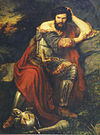
|
c.980 Kiev Son of Sviatoslav I and Predslava |
15 July 1015 – 1019 | Kievan Rus' | Unknown name (daughter of Bolesław I of Poland) no children |
1019 Brest aged 38–39 |
|
| Yaroslav I the Wise Yaroslav George Vladimirovich (Яросла́в Му́дрий) Old Norse: Jarizleifr Valdamarrsson[10] |

|
c.978 Third son of Vladimir I the Great and Rogneda of Polotsk |
1019 – 20 February 1054 | Kievan Rus' | Ingigerda of Sweden 1019 Novgorod eight or nine children |
20 February 1054 Vyshhorod aged 75–76 |
Prince of Rostov, Prince of Novgorod, and Grand Prince of Kiev; during his reign Kievan Rus' reached the pinnacle of its power. |
| Iziaslav I Iziaslav Demetrius Yaroslavich (Ізяслав Ярославич) Old Norse: Izjasleifr(?) Jarizleifsson |
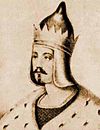
|
c.1024 Second son of Yaroslav I and Ingigerda of Sweden |
20 February 1054 – 14 September 1068 April 1069 – 22 May 1073 15 July 1076 – 3 October 1078 |
Kievan Rus' | Gertrude of Poland 1043 three children |
3 October 1078 Nizhyn aged 53–54 |
Reigned three times, threatened by the power of his relatives Vseslav of Polotsk (1068–69) and Sviatoslav II of Kiev (1073–76). First ruler titled King of Rus' , as Pope Gregory VII sent him a crown from Rome in 1075. |
| Vseslav the Seer Vseslav Basil Bryacheslavich (Всеслав Брячиславич) |

|
c.1039 Polotsk Son of Bryachislav of Polotsk |
14 September 1068 – April 1069 | Kievan Rus' | Unknown six children |
24 April 1101 Polotsk aged 61–62 |
A brief ruler during Iziaslav's official reign. Also Prince of Polotsk. |
| Sviatoslav II Sviatoslav Nicholas Yaroslavich (Святослав Ярославич) Old Norse: Sveinald Jarizleifsson |

|
c.1027 Kiev Third son of Yaroslav I and Ingigerda of Sweden |
22 May 1073 – 15 July 1076 | Kievan Rus' | Cecilia of Dithmarschen [citation needed] Between 1043 and 1047 five children Oda of Stade (Nordmark) c.1065 one son |
27 December 1076 Kiev aged 48–49 |
A brief ruler during his brother Iziaslav's official reign. |
| Vsevolod I Vsevolod Andrew Yaroslavich (Всеволод Ярославич) Old Norse: Vissivald Jarizleifsson |
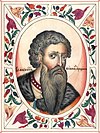
|
c.1030 Fourth son of Yaroslav I the Wise and Ingigerda of Sweden |
3 October 1078 – 13 April 1093 | Kievan Rus' | Anastasia of Byzantium c.1053 two children Anna of the Kipchaks c.1070 four children |
13 April 1093 Vyshhorod aged 62–63 |
Usurped the throne from his nephew, Yaropolk Iziaslavich. |
| Saint Yaropolk Izyaslavich Yaropolk Peter Iziaslavich (Ярополк Ізяславич) Old Norse: Iaropolk Izjasleifsson (?) |
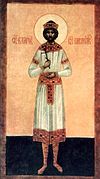
|
c.1043 First son of Iziaslav I and Gertrude of Poland |
3 October 1078 – 22 November 1087 | Kievan Rus' (in opposition) |
Kunigunde of Meissen c.1071 four children |
22 November 1087 Zvenyhorod aged 62–63 |
As hereditary King of Rus (title assumed until his death), was a legitimate contestant for the throne, usurped by his uncle. |
| Sviatopolk II Sviatopolk Michael Iziaslavich (Всеволод Ярославич) Old Norse: Sveinpolk Izjasleifsson (?) |

|
8 November 1050 Second son of Iziaslav I and Gertrude of Poland |
13 April 1093 – 26 April 1113 | Kievan Rus' | Unknown name (daughter of Spytihněv II of Bohemia)[11] c.1085 three children Olenna of the Kipchaks c.1094 four children |
26 April 1113 Vyshhorod aged 62 |
Recovered the throne of his father from his uncle. However, his descendants lost their rights to the Kievan throne. After the division of the territory made in the Council of Liubech of 1097, Kievan Rus' gradually lost its importance, and from 1132 changed name to Kiev. |
| After the Council of Liubech in 1097 Kievan Rus' entered a feudal period and was divided into principalities ruled by the Rurikid family princes who were in a constant power struggle with each other. Major principalities were: Galicia-Volhynia, Kiev, Chernihiv, and Pereyaslavl. In the period of 1240–1362, the three latter ones were forced to accept the Golden Horde overlordship. See List of early East Slavic states | |||||||
| David Sviatoslavich | 
|
1050 Third son of Sviatoslav II and Cecilia of Dithmarschen |
1097 – 1 August 1123 | Chernihiv | Teodosia five children |
1 August 1123 aged 72–73 |
|
| David Igorevich | 
|
1055 Son of Igor Yaroslavich |
1097–1099 | Volhynia | Unknown three children |
25 May 1112 Dorogobuzh aged 56–57 |
Grandson of Yaroslav I. |
| Volodar Rostislavych | 
|
c.1060? First son of Rostislav Vladimirovich of Tmutarakan and Helena of Hungary |
1097 – 19 March 1124 | Halych (at Zvenigorod and Peremyshl) |
? of Pomerania four children |
19 March 1124 aged 63–64? |
Holders of the region since 1092, since 1097 had fuller control over the principality. |
| Vasilko Rostislavich | 
|
c.1066 Second son of Rostislav Vladimirovich of Tmutarakan and Helena of Hungary |
1097 – 28 February 1124 | Halych (at Terebovlia) |
Unknown three children |
28 February 1124 aged 57–58? | |
| Vladimir II Monomakh Vladimir Basil Vsevolodovich (Володимир Мономах) Old Norse: Valdamarr Vissivaldsson |

|
1053 Son of Vsevolod I and Anastasia of Byzantium |
1097 – 26 April 1113 | Pereyaslavl | Gytha of Wessex c.1074 five or six children Euphemia of Byzantium c.1100 six or seven children Unknown name (daughter of Aepa Ocenevich, Khan in Cumania) After 1107 no known children |
19 May 1125 Kiev aged 71–72 |
Ruled against his relative Sviatopolk II until his own accession to the throne in 1113. He is considered to be the last ruler of the united Kievan Rus'. |
| 26 April 1113 – 19 May 1125 | Kievan Rus' | ||||||
| Mstislav Sviatopolkovich | 
|
? Illegitimate son of Sviatopolk II |
1099 – 12 June 1099 | Volhynia | Unknown | 12 June 1099 Volodymyr |
|
| Yaroslav Sviatopolkovich | 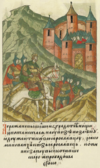
|
c. 1070 Son of Sviatopolk II and ? of Bohemia |
12 June 1099 – 1118 | Volhynia | Unknown (daughter of Ladislaus I of Hungary) c.1091 Judith-Maria of Poland c.1106 Unknown (daughter of Mstislav I of Kiev) c.1112 three/four children in total |
May 1124 aged 53–54 |
Retired in 1118. |
| Sviatoslav Vladimirovich | 
|
1079 Third son of Vladimir II and Gytha of Wessex |
26 April 1113 – 6 March 1114 | Pereyaslavl | Unmarried | 6 March 1114 Pereyaslavl aged 34–35 |
Son of Vladimir II Monomakh. |
| Roman Vladimirovich | 
|
1081 Fourth son of Vladimir II and Gytha of Wessex |
1118 – 6 January 1119 | Volhynia | ? Volodarevna of Peremyshl no children |
6 January 1119 Volodymyr aged 37–38 |
|
| Constantine Sviatoslavich the Blessed[12] | 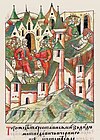
|
1070 First son of Sviatoslav II and Oda of Stade |
1 August 1123 – 1127 | Chernihiv | Unknown three children |
1129 aged 58–59 |
|
| Igor Vasilkovich | 
|
c.1100? First son of Vasilko Rostislavich |
28 February 1124 – 1141 | Halych (at Terebovlia) |
Anna Vsevolodovna of Chernihiv no children |
1141 Halych aged 40–41? |
After their deaths, their cousin Vladimir reunited Terebovlia with Peremyshl and Zvenigorod. |
| Rostislav Vasilkovich | 
|
c.1100? Second son of Vasilko Rostislavich |
Unknown | c.1141 aged 40–41? | |||
| Rostislav Volodarevich | 
|
c.1100 First son of Volodar Rostislavich and ? of Pomerania |
19 March 1124 – 1129 | Halych (at Peremyshl) |
? of Pomerania four children |
1129 aged 28–29? |
Children of Volodar, divided their principalities, but Vladimir ended up reuniting his family's patrimony, forming in 1141 the Principality of Halych. |
| Vladimir Volodarevich | 
|
1104br>Second son of Volodar Rostislavich and ? of Pomerania | 19 March 1124 – 1153 | Halych (at Zvenigorod; in Peremyshl since 1129, and Terebovlia since 1141) |
Sophia of Hungary c.1117 four children |
1153 aged 48–49 | |
| Mstislav I the Great Mstislav Theodore Vladimirovich (Мстислав Великий) Old Norse: Haraldr Valdamarrsson |

|
1 June 1076 Turov First son of Vladimir II and Gytha of Wessex |
19 May 1125 – 14 April 1132 | Kievan Rus' | Christina of Sweden 1095 ten children Liubava Dmitrievna Zavidich 1122 two children |
14 April 1132 Kiev aged 55 |
After his reign Kievan Rus' fell into recession starting a rapid decline: the Rus' became reduced to Kiev. |
| Yaropolk II | 
|
1082 Fifth son of Vladimir II and Gytha of Wessex |
1114 – 14 April 1132 | Pereyaslavl | Helena of Ossetia 1116 one child |
18 February 1139 aged 56–57 |
|
| 14 April 1132 – 18 February 1139 | Kiev | ||||||
| Vsevolod Mstislavich Vsevolod David Mstislavich |

|
1103 Novgorod Second son of Mstislav I and Christina of Sweden |
14 April 1132 – 1132 | Pereyaslavl | Anna before 1125 four children |
11 February 1138 Pskov aged 34–35 |
Also prince in Novgorod (1117–32, 1132–36) and Vyshgorod (1136) |
| Viacheslav I | 
|
1083 Chernihiv Sixth son of Vladimir II and Gytha of Wessex |
1133–1134 | Pereyaslavl | Unknown before 1139 one child |
2 February 1154 Kiev aged 70–71 |
Deposed. |
| 18 February – 4 March 1139 | Kiev | ||||||
| Andrey Vladimirovich the Good | 
|
11 July 1102 Pereyaslavl Second son of Vladimir II and Euphemia of Byzantium or ? of the Kipchaks |
6 January 1119 – 1135 | Volhynia | Unknown (daughter of Tugor-khan of Polotsk) c.1117 two children |
22 January 1141 Pereyaslavl aged 38 |
|
| 1135 – 22 January 1141 | Pereyaslavl | ||||||
| Vsevolod II Vsevolod Kirill Olegovich |

|
1094 First son of Oleg Sviatoslavich and ? of Cumania |
1127 – 4 March 1139 | Chernihiv | Maria Mstislavna of Kiev 1116 one child |
1 August 1146 Vyshgorod aged 51–52 |
Grandson of Sviatoslav II, married Maria, sister of Mstislav I, Yaropolk II and Viacheslav I. |
| 4 March 1139 – 1 August 1146 | Kiev | ||||||
| Vladimir Davidovich | 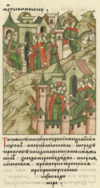
|
c.1110? First son of David Sviatoslavich and Teodosia |
4 March 1139 – 12 May 1151 | Chernihiv | ? Vsevolodovna of Grodno 1144 one child |
12 May 1151 aged c.40–41? |
|
| Saint Igor II | 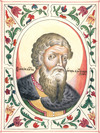
|
1096 Second son of Oleg Sviatoslavich and ? of Cumania |
2 – 12 August 1146 | Kiev | Unmarried | 19 September 1147 aged 50–51 |
Deposed. |
| Iziaslav II | 
|
1096[13] Novgorod First son of Mstislav I and Christina of Sweden |
1132–1133 1141 – 12 August 1146 |
Pereyaslavl | Agnes of Hohenstaufen before 1151 five children Rusudan of Georgia[13] 1154 no children |
13 November 1154[13] Kiev aged 57–58 |
|
| 1135–1141 1146–1151 |
Volhynia | ||||||
| 12 August 1146[14] – 1149 1151 – 13 November 1154 |
Kiev | ||||||
| Yuri I the Long-Armed | 
|
1099 Pereyaslavl Second son of Vladimir II and Euphemia of Byzantium or ? of the Kipchaks |
1132 1134–1135 |
Pereyaslavl | Two wives fifteen children |
15 May 1157 Kiev aged 58–59 |
|
| 1149–1151 1155 – 15 May 1157 |
Kiev | ||||||
| Sviatopolk Mstislavich | 
|
1114 Fourth son of Mstislav I and Christina of Sweden |
1151 – 20 February 1154 | Volhynia | Euphemia of Olomouc[15] 1143 or 1144 no children |
20 February 1154 | |
| Iziaslav III | 
|
1115 Second son of David Sviatoslavich and Teodosia |
1151 – 1154 1155-15 May 1157 |
Chernihiv | Unknown one child |
6 March 1161 Kiev aged 45–46 |
|
| 13 November 1154–1155 15 May 1157 – 12 April 1159 12 February 1161 – 6 March 1161 |
Kiev | ||||||
| Rostislav I | 
|
1110 Kiev Third son of Mstislav I and Christina of Sweden |
8 – 15 December 1154 12 April 1159 – 12 February 1161 6 March 1161 – 14 March 1167 |
Kiev | Unknown eight children |
14 March 1167 aged 56–57 |
|
| Yaroslav Vladimirovich the Eight-Minded | 
|
1130 Son of Vladimir Volodarevich and Sophia of Hungary |
1153 – 1 October 1187 | Halych | Olga Yurievna of Vladimir-Suzdal four children Anastasia one child |
1 October 1187 Halych aged 56–57 |
|
| Sviatoslav Olegovich | 
|
1106/07 Third son of Oleg Sviatoslavich and ? of Cumania |
1154–1155 15 May 1157 – 14 February 1164 |
Chernihiv | ? of Cumania two children Ekaterina Petrovna of Novgorod four children |
14 February 1164 aged 58–60 |
|
| Mstislav II the Brave | 
|
1125 First son of Iziaslav II and Agnes of Hohenstaufen |
12 August 1146 – 1149 6 April 1151 – 1154 |
Pereyaslavl | Agnes of Poland 1151 three children |
19 August 1170 Veliky Novgorod aged 44–45 |
|
| 1157 – 19 August 1170 | Volhynia | ||||||
| 19 May 1167 – 12 March 1169 March 1170 – 19 August 1170 |
Kiev | ||||||
| Rostislav Yurievich | 
|
c.1120? First son of Yuri I |
1149 – 6 April 1151 | Pereyaslavl | Unknown before 1151 three children |
6 April 1151 Pereyaslavl aged |
Son of Yuri I. |
| Gleb | 
|
1125 Fourth son of Yuri I |
1154–1169 | Pereyaslavl | ? Iziaslavna of Chernihiv 1154 three children |
20 January 1171 Kiev aged 45–46 |
|
| 1169 1170 – 20 January 1171 |
Kiev | ||||||
| Vladimir III | 
|
1132 First son of Mstislav I and Liubava Dmitrievna Zavidich |
1154–1157 | Volhynia | Unknown (daughter of Grand Prince Beloš Vukanović of Serbia) 1150 four children |
30 May 1171 Kiev aged 38–39 |
|
| 17 February 1171 – 30 May 1171 | Kiev | ||||||
| Vladimir Glebovich | 1157 Son of Gleb and ? Iziaslavna of Chernihiv |
1169 – 18 April 1187 | Pereyaslavl | Unknown 1180 no children |
18 April 1187 Pereyaslavl aged 29–30 |
||
| Sviatoslav Mstislavich | 
|
? Third son of Mstislav II and Agnes of Poland |
19 August 1170 – 1173 | Volhynia | Unknown | 1173 or 1193 | |
| Michael I | 
|
1145 Suzdal Tenth son of Yuri I |
12 June – 1 July 1171 | Kiev | Fevronia before 1176 two children |
20 June 1176 Gorodets aged 30–31 |
Also Grand Duke of Vladimir (1175–1176). |
| Roman I | 
|
c.1130 Smolensk First son of Rostislav I |
1 July 1171–1173 1175–1177 |
Kiev | Maria Sviatoslavna of Chernihiv 9 January 1149 three children |
14 June 1180 Smolensk aged 49–50 |
|
| Vsevolod III the Big Nest | 
|
19 October 1154 Dmitrov Eleventh son of Yuri I |
1173 | Kiev | Maria Shvarnovna fourteen children Liubava Vasilkovna of Vitebsk 1209 no children |
15 April 1212 Vladimir aged 57 |
Also Grand Duke of Vladimir (1176–1212). |
| Rurik II | 
|
c.1137 Second son of Rostislav I |
1173 1180–1182 1194–1202 1203–1204 1206 1207–1210 |
Kiev | Unknown 1163 Anna Yurievna of Turov[16] before 1176 six children |
19 April 1214 Chernihiv aged 76–77 |
Also Prince of Ovruch (1167–1194), city which was probably his original seat. |
| 1212 – 19 April 1214[17] | Chernihiv | ||||||
| Sviatoslav III | 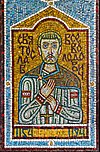
|
1123 Chernihiv First son of Vsevolod II and Maria Mstislavna of Kiev |
1141–1146 | Volhynia | Maria Vasilkovna of Polotsk 1143 eight children |
25 July 1194 Brest aged 70–71 |
|
| 14 February 1164 – 1180 | Chernihiv | ||||||
| 1173–1174 1177–1180 1182 – 25 July 1194 |
Kiev | ||||||
| Yaroslav II | 
|
1132 Second son of Iziaslav II and Agnes of Hohenstaufen |
1174–1175 1180 |
Kiev | Richeza of Bohemia 1149 four children |
1180 Lutsk aged 47–48 |
|
| Yaroslav Vsevolodovich | 
|
1139 Chernihiv Second son of Vsevolod II and Maria Mstislavna of Kiev |
1180–1198 | Chernihiv | Irene[18][19] before 1171 three children |
1198 aged 58–59 |
|
| Yaroslav Mstislavich the Red | 
|
c.1160 Son of Mstislav Yurevich of Vladimir-Suzdal and ? of Cumania |
18 April 1187 – 1199 | Pereyaslavl | Unmarried | 1199 aged 38–39 |
Grandson of Yuri I. |
| Oleg Yaroslavich Nastasich | 
|
? Son of Yaroslav Vladimirovich and Anastasia |
1 October 1187 – 1187 | Halych | Unknown | 1187/8 Halych |
|
| Vladimir Yaroslavich | 
|
1151 Son of Yaroslav Vladimirovich and Olga Yurievna of Vladimir-Suzdal |
1187–1188 1189–1199 |
Halych | Boleslava c.1166 one child |
1199 Halych aged 46–47 |
After his death, Halych reunited with Volhynia. |
| Igor Sviatoslavich the Brave Igor Yuri Sviatoslavich (Ігор Святославич) Old Norse:Ingvar Sveinaldsson |

|
2 April 1151 Novhorod-Siverskyi First son of Sviatoslav Olegovich and Ekaterina Petrovna of Novgorod |
1198 – 29 December 1202 | Chernihiv | Euphrosyne Yaroslavna of Halych[20] before 1170 five children |
29 December 1202 Chernihiv aged 51 |
|
| Ingvar | 
|
1152 Son of Yaroslav II and Richeza of Bohemia |
1202–1203 1212–1214 |
Kiev | Unknown five children |
1220 aged 68–69 |
|
| Roman I the Great (Роман Мстиславич) |
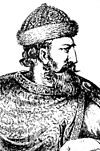
|
1152 First son of Mstislav II and Agnes of Poland |
1188–1189 | Halych | Predslava Rurikovna of Ovruch 1170 or 1180 two children Anna-Euphrosyne Angelina c.1197 two children |
19 June 1205 Zawichost aged 52–53 |
Son-in-law of Rurik II. His reign marked the rise of Galicia-Volhynia as a Kievan Rus' successor state. Galicia-Volhynia was a Ruthenian |
| 1173–1188 1188–1198 |
Volhynia | ||||||
| 1198 – 19 June 1205 (as Prince[27]) |
Volhynia & Halych, then Galicia-Volhynia | ||||||
| February 1204 – 19 June 1205 | Kiev | ||||||
| Vsevolod Mstislavich | 
|
c.1160 Fourth son of Mstislav II and Agnes of Poland |
1188 | Volhynia | Unknown three children |
April 1195 Belzaged 34–35 |
|
| Rostislav II | 
|
13 April 1172 First son of Rurik II and Anna Yurievna of Turov |
February 1204 – 19 June 1205 | Kiev | Verchoslava Vsevolodovna of Vladimir-Suzdal 15 June 1187 one child |
3 March 1218 aged 45 |
Son-in-law of Vsevolod III. Ruled with Roman the Great, his brother-in-law. |
| Oleg Sviatoslavich | 
|
1147 Son of Sviatoslav Olegovich and ? of Cumania |
29 December 1202 – 1204 | Chernihiv | Euphrosyne Yurievna of Yelets 1176 two children |
1204 Chernihiv aged 56–57 |
|
| Vsevolod IV the Red | 
|
c.1150 Second son of Sviatoslav III and Maria Vasilkovna of Polotsk |
1204 – 1212 19 April 1214 – August 1215 |
Chernihiv | Maria Anastasia of Poland 14 October or 24 December 1178[citation needed] or 14 November 1179 four children |
August 1215 Chernihiv aged 64–65 |
|
| 1206–1207 1210 – August 1215 |
Kiev | ||||||
| Regency of Anna-Euphrosyne Angelina (1205–1214) | Held many titles since early childhood culminating with the crowning by a papal legate, archbishop Opizo, in Dorohychyn in 1253, King of Rus'. the title became hereditary in his domains. | ||||||
| Daniel (Данило Романович) |

|
1201 Halych Son of Roman the Great and Anna-Euphrosyne Angelina |
19 June 1205 – 1264 | Galicia-Volhynia | Anna Mstislavna of Novgorod c.1220 eight children ? of Lithuania (niece of Mindaugas) c.1250 no children |
1264 Kholm aged 62–63 | |
| Coloman of Galicia (Kálmán) |

|
1208 Second son of Andrew II of Hungary and Gertrude of Merania |
1215–1221 | Galicia-Volhynia (in opposition) |
Salomea of Poland 1215 no children |
May 1241 Čazma aged 32–33 |
Hungarian prince Kálmán, Prince of Halych (1214–15), became the first anointed and crowned and King of Galicia-Volhynia (rex Galiciae et Lodomeriae) in 1215. Despite that, the first nominal king of Galicia was Andrew II of Hungary (r.1188–90).[28][29][30] Also Duke of Slavonia from 1226. |
| Mstislav III the Old | 
|
1156 Smolensk Second son of Roman I and Maria Sviatoslavna of Chernihiv |
19 April 1214 – 2 June 1223 | Kiev | Unknown 1116 seven children |
2 June 1223 Kalchyk River aged 66–67 |
|
| Gleb Sviatoslavich | 
|
1168 Fourth son of Sviatoslav III and Maria Vasilkovna of Polotsk |
August 1215 – 1217 | Chernihiv | Anastasia Rurikovna of Ovruch 1183 three children |
1220[18] aged 51–52 |
Son-in-law of Rurik II. |
| Mstislav Sviatoslavich | 
|
c.1170 Fifth son of Sviatoslav III and Maria Vasilkovna of Polotsk |
1217 – 31 May 1223 | Chernihiv | Yasynya-Marfa Shvarnovna 1183 four children |
31 May 1223 Kalchyk River aged 66–67 |
Brother-in-law of Vsevolod III. |
| Vladimir IV | 
|
September–December 1187 Second son of Rurik II and Anna Yurievna of Turov |
1206–1213 | Pereyaslavl | Unknown before 1239 four children |
3 March 1239 Ovruch aged 51 |
|
| 2 June 1223 – 1235 1236 – 3 March 1239 |
Kiev | ||||||
| Vladimir Vsevolodovich | 
|
25 October 1193 Sixth son of Vsevolod III and Maria Shvarnovna |
1213–1215[31] | Pereyaslavl | unknown before 1239 four children |
6 December 1227 Starodub-on-the-Klyazma aged 34 |
After his death the Principality was integrated on the Principality of Yaroslavl and then on the Principality of Vladimir. |
| Pereyaslavl was annexed by Yaroslavl, and then by Vladimir-Suzdal. See Russian rulers for later princes. | |||||||
| Iziaslav IV | 
|
1186 Son of Mstislav III |
1235–1236 | Kiev | Agafia no children |
1255 aged 68–69 |
|
| Yaroslav III | 
|
8 February 1191 Pereslavl-Zalessky Fifth son of Vsevolod III and Maria Shvarnovna |
1199–1206 | Pereyaslavl | Unknown 1205 no children Rostislava of Novgorod 1214 (annulled 1216) no children Teodosia Mstislavna of Ryazan 1218 twelve children |
30 September 1246 Karakorum aged 55 |
Also Grand Duke of Vladimir (1238–1246). |
| 1236–1238 20 – 30 September 1246 |
Kiev | ||||||
| Saint Michael II | 
|
1179 Kiev First son of Vsevolod IV and Maria Anastasia of Poland |
1206 | Pereyaslavl | Helena Daniilovna of Galicia-Volhynia 1210 or 1211[32] seven children |
20 September 1246 Sarai aged 66–67 |
While in negotiations with the Golden Horde, his son Rostislav took briefly Kiev throne in 1239, before being expelled by Daniel of Galicia, who protected Kiev's throne until Michael's return in 1240. However, the city was destroyed in that year. Regained Chernihiv throne in 1243, co-ruling with his cousin Andrey Mstislavich. |
| 31 May 1223 – 1234 1243 – 20 September 1246 |
Chernihiv | ||||||
| 1238–1239 1239 – 20 September 1246 |
Kiev | ||||||
| Mstislav Glebovich | c.1210? Son of Gleb Sviatoslavich and Anastasia Rurikovna of Ovruch |
1234–1239 | Chernihiv | Unknown before 1239 two children |
1239/40 aged 29–30? |
||
| Rostislav III | 
|
1189 Son of Mstislav III |
1239 | Kiev | Unknown five children |
align="center"c.1240 aged 50–51 |
While Michael II was negotiating with the Golden Horde, Rostislav took Kiev in 1239, but was expelled by Daniel of Galicia, who put Voivode Dmytro to protect Kiev's throne. |
| Rostislav Mikhailovich | 
|
1219 First son of Michael II and Helena Daniilovna of Galicia-Volhynia |
1239–1243 | Chernihiv | Anna of Hungary 1243 five children |
1262 Belgrade aged 42–43 |
While his father was negotiating with the Golden Horde, Rostislav took Chernihiv in 1239, which then returned to Michael. Rostislav made most of his career out of Rus', competing for the Bulgarian throne, and holding the titles of Duke of Macsó and Ban of Slavonia. |
| Andrey Mstislavich[33] | ? Son of Mstislav Glebovich |
1245–1246 | Chernihiv | Unknown | 1246 | Co-ruling with Michael II in Chernihiv. | |
| Saint Alexander Nevsky | 
|
13 May 1221 Pereslavl-Zalessky Second son of Yaroslav III and Teodosia Mstislavna of Ryazan |
30 September 1246 – 14 November 1263 | Kiev | Praskovia-Alexandra Bryacheslavna of Polotsk 1239 five children Vassilissa before 1263 no children |
14 November 1263 Gorodets aged 42 |
Also Grand Prince of Vladimir (1252–1263). |
| Andrey Vsevolodovich | c.1190 Second son of Vsevolod IV and Maria Anastasia of Poland |
20 September 1246 – 1263 | Chernihiv | Unknown | 1263 aged 72–73 |
||
| Yaroslav IV | 
|
1230 Sixth son of Yaroslav III and Teodosia Mstislavna of Ryazan |
14 November 1263 – 16 September 1271 | Kiev | Natalia before 1252 two children Saint Xenia of Tarusa 1265 four children |
16 September 1271 Tver aged 40–41 |
Also Grand Prince of Vladimir. |
| Roman Mikhailovich I the Elder | c.1220 Second son of Michael II and Helena Daniilovna of Galicia-Volhynia |
1263–1288 | Chernihiv | Anna four children |
1288 aged c.67–68 |
||
| Leo I (Лев Дани́лович) |

|
1228 Second son of Daniel and Anna Mstislavna of Novgorod |
1264–1301 | Galicia-Volhynia | Constance of Hungary 1246/47 three children |
1301 Lviv aged 72–73 |
Moved the capital of Galicia from Kholm to Lviv in 1272. After his death Kiev fell to Lithuania: until at least 1362, were installed Lithuanian governors in Kiev.[34] |
| 16 September 1271 – 1301 | Kiev | ||||||
| Kiev annexed to Lithuania | |||||||
| Oleg Romanovich | 
|
c.1245 Second son of Roman Mikhailovich I and Anna |
1288-1292/1303 | Chernihiv | Unmarried | 30 September 1307 aged c.61–62 |
Resigned. |
| Michael Alexandrovich | c.1240 Son of Alexander Romanovich, Prince of Bryansk |
1292/1303-1307 | Chernihiv | Unknown one child |
After 1307 Chernihiv aged c.60–61 |
Grandson of Roman Mikhailovich I. With his death, the Chernigov line apparently died out; the principality was taken by the Ruriks of Smolensk, princes of Bryansk and descendants of Rostislav I and Roman I. | |
| Chernihiv annexed to the Principality of Bryansk (1307–1401) and then to Lithuania (since 1401) | |||||||
| Yuri I (Ю́рій Льво́вич) |

|
24 April 1252 Lviv Son of Leo I and Constance of Hungary |
1301 – 21 April 1308 | Galicia-Volhynia | Xenia Alexandrovna of Vladimir-Suzdal 1282 one child Euphemia of Kuyavia 1287 four children |
21 April 1308 Lviv aged 55 |
|
| Andrey (Андрій Юрієвич) |

|
c.1290 Lviv First son of Yuri I and Euphemia of Kuyavia |
21 April 1308 – May 1323 | Galicia-Volhynia | Unknown one child |
May 1323 Berestia aged c.32–33 |
Ruled jointly, and died also together in battle. |
| Leo II (Лев Юрійович) |

|
c.1290 Lviv Second son of Yuri I and Euphemia of Kuyavia |
Unknown | ||||
| Maria (Марія Юріївна) |
c.1290 Lviv First daughter of Yuri I and Euphemia of Kuyavia |
May 1323 – 11 January 1341 | Galicia-Volhynia (in Halych and Lviv) |
Trojden I, Duke of Masovia 1310 four children |
11 January 1341 aged c.50–51 |
Heiresses of the realm, and the true owners of power, Maria and Euphemia (aunt and niece) divided Halych-Volhynia in halves, and ruled them with their respective co-rulers: Maria ruled with her son, and Euphemia with her husband. Their division would also dictate the later Galicia–Volhynia Wars, in which Poland claimed all of the kingdom by having a higher claim than Lithuania. In spite of this, Poland kept only Halych, while Volhynia was annexed to Lithuania. | |
| Yuri II Boleslav[35] (Юрій-Болеслав Тройденович) |

|
1311 Lviv First son of Trojden I, Duke of Masovia and Maria |
May 1323 – 7 April 1340 | Euphemia of Lithuania (uk) 1331 no children |
7 April 1340 Volodymyraged 28–29 | ||
| Anna-Euphemia (Ганна-Буча-Євфимія Андрійівна) |
c.1310 Lviv Daughter of Andrey |
May 1323 – c.1345? | Galicia-Volhynia (in Volhynia and Lutsk) |
Liubartas 1321/23 no children |
1345? aged c.34–35? | ||
| Liubartas (Лю́барт-Дмитро) |

|
1311 Son of Gediminas, Grand Duke of Lithuania and Jaunė |
Anna-Euphemia 1321/23 no children Olga Agafiya Konstantinovna of Rostov 1349 four children |
4 August 1383 aged 71–72 | |||
| Halych annexed to Poland; Volhynia annexed to Lithuania | |||||||
Under the Grand Duchy of Lithuania (1362–1471)
[edit]In the early 1320s, a Lithuanian army led by Gediminas defeated a Slavic army led by Stanislav of Kiev at the Battle on the Irpen' River, and conquered the city. The Tatars, who also claimed Kiev, retaliated in 1324–1325, so while Kiev was ruled by a Lithuanian prince, it had to pay a tribute to the Golden Horde. Finally, as a result of the Battle of Blue Waters in 1362, Kiev and surrounding areas were incorporated into the Grand Duchy of Lithuania by Algirdas, Grand Duke of Lithuania.
- Algimantas Alšėniškis (Olgimunt Holszański, Olgimont-Mykhailo Olshansky) (1324–1331)
- Fiodor of Kiev a.k.a. Teodoras Butvydaitis, brother of Gediminas (1331–1362)
- Vladimiras Algirdaitis (Volodymyr Olgerdovych) (1362–1394)
- Skirgaila (1395–1397)
- Ivan Olshansky (Jonas Alšėniškis) (1397–c. 1402)
- Jurgis Gedgaudas; lt (Jerzy Giedygołd) (1404–1411)
- Andriy Ivanovych Olshansky (c. 1412–c. 1422)
- Mykhailo Ivanovych Olshansky (1422–1432)
- Mykhailo Semenovych Boloban Olshansky (1433–1435)
- Švitrigaila (1435–c. 1440), Grand Duke of the Rus' (1432–c. 1440)
- Aleksandras Olelka (Olelko Volodymyrovych) (1443–1454)
- Simonas Olelkaitis (Semen Olelkovych) (1454–1471)
Voivodes of Kiev
[edit]
Under the Grand Duchy of Lithuania (1471–1569)
[edit]- Martynas Goštautas (Marcin Gasztołd) (1471–1475)
- Ivan Chodkiewicz (Jonas Ivanas Chodkevičius) (1480–1484)
- Jerzy Pac (Jurgis Pacas) (1486–1492)
- Dymitr Putiatycz (Dmytro Putyatych) (1492–1505)
- Jerzy Montowtowicz (Jurgis Montovtt) (1505–1508)
- Jan Gliński (Jonas Glinskis, Ivan Hlynsky) (1508)
- Jerzy Holszański (Jurgis Alšėniškis, Yuriy Olshansky) (1508–1511)
- Jerzy Radziwiłł (Jurgis Radvila) (1511–1514)
- Andrzej Niemirowicz (Andriy Nemyrych) (1514–1541)
- Jan Holszański (Ivan Olshansky) (1542–1544)
- Fryderyk Proński (Semen Hlebovych Pronsky, Frederikas Prunskis) (1545–1555)
- Hrehory Chodkiewicz (Grigorijus Chodkevičius) (1555–1559)
- Konstanty Wasyl Ostrogski (Kostiantyn Vasyl Ostrozky) (1559–1569)
Under the Polish-Lithuanian Commonwealth (1569–1793)
[edit]When the Polish–Lithuanian Commonwealth was formed by the Union of Lublin in 1569, Kiev and surrounding areas, Podolia, Volhynia, and Podlaskie, as the Kiev Voivodeship, Bratslav Voivodeship, Volhynian Voivodeship, and Podlaskie Voivodeship, were transferred from Lithuania to Poland.
- Konstanty Wasyl Ostrogski (1569–1608)
- Stanisław Żółkiewski (1608–1618)
- Tomasz Zamoyski (1619–1628)
- Aleksander Zasławski (1629)
- Stefan Chmielecki (1629–1630)
- Janusz Tyszkiewicz (1630–1649)
- Adam Kisiel (1650–1653)
- since 1654 in Zhytomyr
- Stanisław Rewera Potocki (1655–1658)
- Jan Zamoyski (1658–1659)
- Jan Wyhowski (1659–1664)
- Stefan Czarniecki (1664–1665)
- Michał Stanisławski (1665–1668)
- Andrzej Potocki (1668–1681)
- Feliks Kazimierz Potocki (1682)
- Stefan Niemirycz (1682–1684)
- Marcin Kątski (1684–1702)
- Józef Potocki (1702–1744)
- Stanisław Potocki (1744–1756)
- Franciszek Salezy Potocki (1756–1772)
- Stanisław Lubomirski (1772–1785)
- Józef Gabriel Stempkowski (1785–1791)
- Antoni Protazy Potocki (1791–1793)
Cossack Hetmans
[edit]A Hetman was a military and civil leader, democratically elected by the Cossacks.
Under Lithuania and Poland (1486–1646)
[edit]Several Cossack regiments were operating in Ukraine at this time that were largely independent of each other, so some of the Hetmans' tenures overlap.
| 1486–1492 | Yurii Pats | governor of Kyiv; organizer Cossack units. | |
| 1488–1495 | Bohdan Hlynskyi | Cossack leader, destroyer Ochakov. | |
| 1492–1505 | Dmytro Putyatych | Cossack leader. | |
| 1510–1524 | Senko Polozovych | governor of Kyiv; Cossack leader. | |
| 1514–1535 | Ostap Dashkevych | Cossack leader. | |
| 1516–1528 | Przecław Lanckoroński | Cossack leader. | |
| 1550–1557 | Dmytro Vyshnevetsky | founder of the fortress at Minor Khortytsia. | |
| 1568 | Semen Birulia | Cossack leader. | |
| 1568 | Karpo Maslo | Cossack leader. | |
| 1568 | Andrush | Moldavian boyar Cossack leader. | |
| 1568 | Lisun | Cossack leader. | |
| 1568 | Yatsko Bilous | Cossack leader. | |
| 1568 | Andrii Liakh | Cossack leader. | |
| 1577–1578 | Ivan Pidkova | Cossack leader. | |
| 1578 | Lukian Chornynskyi | Cossack leader, hetman. | |
| 1581 | Samiilo Zborovskyi | Cossack leader, hetman. | |
| 1584 | Bohdan Mykoshynskyi | Cossack leader, hetman. | |
| 1585 | Mykhailo Ruzhynskyi | Cossack leader, hetman. | |
| 1585 | Kyryk Ruzhynskyi | Cossack leader, hetman. | |
| 1585 | Zakhar Kulaha | Cossack leader, hetman. | |
| 1586 | Lukian Chornynskyi | Cossack leader, hetman. | |
| 1586 | Bohdan Makoshynskyi | Cossack leader, hetman. | |
| 1588 | Potrebatskyy | Cossack leader, hetman. | |
| 1589 | Zachary Kulaga | Cossack leader, hetman. | |
| 1594 | Bohdan Mykoshynskyi | Cossack leader, hetman. | |
| 1594–1596 | Hryhoriy Loboda | Cossack leader. | |
| 1594–1596 | Severyn Nalyvaiko | Cossack leader. | |
| 1596 | Matvii Shaula | Cossack leader, hetman. | |
| 1596 | Kryshtof Krempskyi | Cossack leader, hetman. | |
| 1596 | Kryshtof Nechkovskyi | Cossack leader, hetman. | |
| 1596–1597 | Hnat Vasylevych | Cossack leader, hetman. | |
| 1597 | Tykhin Baibuza | Cossack leader, hetman. | |
| 1598 | Florian Hedroits | Cossack leader. | |
| 1598 | Mitlovskyi | Cossack leader. | |
| 1602–1603 | Ivan Kutskovych | Cossack leader, hetman. | |
| 1603 | Ivan Kosyi | Cossack leader, hetman. | |
| 1606 | Hryhorii Izapovych | Cossack leader, hetman. | |
| 1606 | Samiilo Zborovskyi | Cossack leader, hetman. | |
| 1606 | Bohdan Olevchenko | Cossack leader, hetman. | |
| 1617 | Dmytro Barabash | Cossack leader, hetman. | |
| 1618 | Mykhailo Skyba | Cossack leader. | |
| 1619–1621 | Yatsko Nerodych | Cossack leader, hetman. | |
| 1620 | Petro Odynets | Cossack leader. | |
| 1624 | Hryhoriy Chorny | Cossack leader, hetman. | |
| 1625 | Fedir Pyrskyi | Cossack leader, hetman. | |
| 1628 | Hryhoriy Chorny | Cossack leader, hetman. | |
| 1629–1630 | Hryhoriy Chorny | Cossack leader, hetman. | |
| 1630 | Taras Fedorovych | Cossack leader, hetman. | |
| 1632 | Andrii Didenko | Cossack leader, hetman. | |
| 1633 | Dorofii Doroshenko | Cossack leader, acting hetman. | |
| 1633 | Dorosh Kutskovych | Cossack leader, acting hetman. | |
| 1633 | Hyria Kanevets | Cossack leader. | |
| 1633–1635 | Ivan Sulyma | Cossack leader, hetman. | |
| 1636–1637 | Vasyl Tomylenko | Cossack leader, hetman. | |
| 1637 | Pavlo Pavliuk | Cossack leader, hetman. | |
| 1638 | Yakiv Ostrianyn | Cossack leader, hetman. | |
| 1638 | Dmytro Hunia | Cossack leader, hetman. | |
| 1639–1642 | Karpo Pivtora-Kozhukha | Cossack leader, hetman. | |
| 1642–1646 | Maksym Hulak | Cossack leader, hetman. |
Cossack Hetmanate (1648–1764)
[edit]Following the Khmelnytsky uprising a new Cossack republic, the Hetmanate, was formed.
| No. | Hetman | Elected (event) | Took office | Left office | |||
|---|---|---|---|---|---|---|---|
| 1 | 
|

|
Bohdan Khmelnytsky (1596–1657) Зиновій-Богдан Хмельницький |
1648 (Sich) | 26 January 1648 | 6 August 1657 | died |
| 2 | 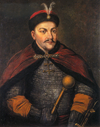
|

|
Yurii Khmelnytsky (1641–1685) Юрій Хмельницький |
death of his father | 6 August 1657 | 27 August 1657 | reconsidered by the Council of Officers |
| 3 | 
|

|
Ivan Vyhovsky (????–1664) Іван Виговський |
1657 (Korsun) | 27 August 1657 (confirmed: 21 October 1657) |
11 September 1659 | surrendered title |
| 4 | 
|

|
Yurii Khmelnytsky (1641–1685) Юрій Хмельницький |
1659 (Hermanivka) | 11 September 1659 (confirmed: 11 September 1659) |
October 1662 | surrendered title |
| – | Pavlo Teteria (1620?–1670) Павло "Тетеря" Моржковський |
1662 (Chyhyryn) | October 1662 | July 1665 | (legitimacy questioned) | ||
| 5 | 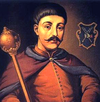
|
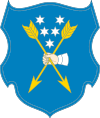
|
Ivan Briukhovetsky (1623–1668) Іван Брюховецький |
1663 (Nizhyn) | 27 June 1663 (confirmed: 27 June 1663) |
17 June 1668 | died |
| 6 | 
|

|
Petro Doroshenko (1627–1698) Петро Дорошенко |
1666 (Chyhyryn) | 10 October 1665 (confirmed: January 1666) |
19 September 1676 | surrendered to Ivan Samoylovych |
| – | Demian Mnohohrishny (1631–1703) Дем'ян Многогрішний |
1669 (Hlukhiv) | 17 December 1668 (confirmed: 3 March 1669) |
April 1672 | arrested and exiled to Siberia | ||
| 7 | 
|

|
Ivan Samoylovych (1630s–1690) Іван Самойлович |
1672 (Cossack Grove) | 17 June 1672 | August 1687 | arrested and exiled to Siberia |
| 8 | 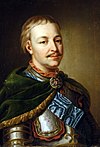
|

|
Ivan Mazepa (1639-1709) Іван Мазепа |
1687 (Kolomak) | 4 August 1687 | 6 November 1708 | "stripped" of a title, discredited |
| 9 | 
|
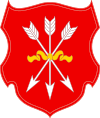
|
Ivan Skoropadsky (1646–1722) Іван Скоропадський |
1708 (Hlukhiv) | 6 November 1708 | 14 July 1722 | died |
| – | Pavlo Polubotok (1660–1724) Павло Полуботок |
appointed hetman | 1722 | 1724 | died in prison | ||
| Collegium of Little Russia (Stepan Velyaminov) 1722-1727 | |||||||
| 10 | 
|

|
Danylo Apostol (1654–1734) Данило Апостол |
1727 (Hlukhiv) | 12 October 1727 | 29 March 1734 | died |
| – | Yakiv Lyzohub (1675–1749) Яків Лизогуб |
appointed hetman | 1733 | 1749 | died | ||
| provisional Hetman Government Administration 1734-1745 | |||||||
| 11 | 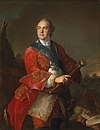
|
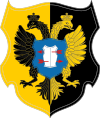
|
Kyrylo Rozumovsky (1728–1803) Кирило Розумовський |
1750 (Hlukhiv) | 22 February 1750 | 1764 | resigned |
| Collegium of Little Russia 1764-1786 (Pyotr Rumyantsev) | |||||||
Historians such as Mykola Arkas[36] question legitimacy of the Teteria's elections accusing the later in corruption.[37] Also some sources claim election of Teteria being taken place in January 1663.[38] The election of Teteria led to the Povoloch Regiment Uprising in 1663, followed by bigger number of unrest in the modern region of Kirovohrad Oblast as well as Polesie (all in the Right-bank Ukraine).[39] Moreover, the political crisis that followed the Pushkar–Barabash Uprising divided the Cossack Hetmanate completely on both bank of Dnieper River.[39] Coincidentally, on 10 January 1663, the Tsardom of Muscovy created the new Little Russian Office (Prikaz) within its Ambassadorial Office.
Vouched by Charles Marie François Olier, marquis de Nointel, Yuriy Khmelnytsky was freed from the Ottoman captivity, appointed and along with Pasha Ibragim was sent to Ukraine fight the Moscow forces of Samoilovych and Romadanovsky. In 1681 Mehmed IV appointed George Ducas the Hetman of Ukraine, replacing Khmelnytsky.
Following the anathema on Mazepa and the election of Ivan Skoropadsky, Cossack Hetmanate was included into the Russian Government of Kiev in December 1708. Upon the death of Skoropadsky, the Hetman elections were disrupted and were awarded as a gift and a type of princely titles, first to Moldavian nobleman and later to the Russian Empress favorite.
On 5 April 1710 the council of cossacks, veterans of the battle at Poltava, elected Pylyp Orlyk as the Hetman of Ukraine in exile. Orlyk waged a guerrilla warfare at the southern borders of the Russian Empire with the support from Ottoman and Swedish empires.The Ruin (1660–1764) was a time in Ukrainian history when the country fell into disarray and chaos. Afterwards, the Cossack state emerged as a vassal of the Russian Empire. During this period a number of hetmans stayed in power for short periods of time and often controlled only parts of the country. Moreover, the Treaty of Andrusovo (1667) split the Cossack Hetmanate along the Dnieper River into Left-bank Ukraine, which enjoyed a degree of autonomy within the Tsardom of Russia; and Right-bank Ukraine which remained part of the Polish–Lithuanian Commonwealth, and at times (1672–1699) part of the Ottoman Empire.
| Right-bank Ukraine | Left-bank Ukraine | ||||||
|---|---|---|---|---|---|---|---|
| Polish protectorate | Russian protectorate | ||||||
| 1660—1663 | Yurii Khmelnytsky | 1660—1663 | Yakym Somko | ||||
| 1663—1665 | Pavlo Teteria | 1663—1668 | Ivan Briukhovetsky | ||||
| 1665—1668 | Petro Doroshenko | ||||||
| Unification | |||||||
| 1668—1669 | Petro Doroshenko | ||||||
| Partition | |||||||||||
|---|---|---|---|---|---|---|---|---|---|---|---|
| Right-bank Ukraine | Left-bank Ukraine | ||||||||||
| Osman protectorate | Polish protectorate | Russian protectorate | Swedish protectorate | ||||||||
| 1669—1676 | Petro Doroshenko | 1669—1674 | Mykhailo Khanenko | 1669—1672 | Demian Mnohohrishny | ||||||
| 1678—1681 | Yurii Khmelnytsky | 1675—1679 | Ostap Gogol | 1672—1687 | Ivan Samoilovych | ||||||
| 1681—1684 | Gheorghe Duca | 1683—1684 | Stefan Kunicki | ||||||||
| 1685 | Yurii Khmelnytsky | 1684—1689 | Andrii Mohyła | ||||||||
| 1687—1708 | Ivan Mazepa | ||||||||||
| Unification | |||||||||||
| 1708—1722 | Ivan Skoropadsky | 1708—1709 | Ivan Mazepa | ||||||||
| 1708—1718 | Pylyp Orlyk | ||||||||||
| 1718—1742 | Pylyp Orlyk | 1722—1724 | Pavlo Polubotok | ||||||||
| 1727—1734 | Danylo Apostol | ||||||||||
| 1750—1764 | Kirill Razumovsky | ||||||||||
Under the Russian Empire and the Habsburg monarchy
[edit]After the dissolution of the Cossack Hetmanate, a new Little Russian collegium was established in 1764, and the Zaporozhian Host was disbanded in 1775. As a result of the second and third Partitions of Poland in 1793 and 1795, eastern and central parts of the territory of present-day Ukraine were incorporated directly into the Russian Empire. The western part became part of the Habsburg monarchy earlier, in the following order: Carpathian Ruthenia (1526/1699), Galicia (1772), and Bukovina (1775).
Ukraine In the Russian Empire (1721–1917)
1721 – 1725 Peter I the Great (Петро І Великий)
1725 – 1727 Catherine I (Катерина І)
1727 – 1730 Peter II (Петро II)
1730 – 1740 Anna (Анна)
1741 – 1742 Elizabeth (Єлизавета Петрівна)
1742 Peter III (Петро III)
1762 – 1796 Catherine II the Great (Катерина II Велика)
1796 – 1801 Paul I (Павло І)
1801 – 1825 Alexander I the Blessed (Олександр I Блаженний)
1825 – 1855 Nicholas I (Микола І)
1855 – 1881 Alexander II the Liberator (Олександр II Визволитель)
1881 – 1894 Alexander III the Peacemaker (Олександр III Миротворець)
1894 – 1917 Nicholas II (Микола II)
The Kingdom of Galicia and Lodomeria in the Austrian Empire (1772–1918)
1772 – 1780 Maria Theresa (Марія Терезія)
1780 – 1790 Joseph II (Йосип II)
1790 – 1792 Leopold II (Леопольд II)
1792 – 1835 Francis II (Франциск II)
1835 – 1848 Ferdinand I (Фердинанд І)
1848 – 1916 Francis Joseph I (Франц Йосип І)
1916 – 1918 Charles I (Карл I)
Leaders during the Russian Revolution
[edit]Ukrainian People's Republic (1917–1921)
[edit]The Ukrainian People's Republic was formed after the Russian Revolution of 1917, and lasted until the Peace of Riga between Poland and Soviet Russia in March 1921. The state leadership position title varied and, despite a rather widespread misconception, none of them had an official Presidential title.
The Directorate of Ukraine was a provisional council of the UNR formed after Skoropadskyi's Hetmanate fell apart. On 22 January 1919, the Act of Unification of the Ukrainian People's Republic and the West Ukrainian People's Republic was passed. The text of the universal was made by the members of the Directory.
| No. | Picture | Name (Birth–Death) |
Began office | Left office | Party | Title(s) |
|---|---|---|---|---|---|---|
| — | 
|
Volodymyr Pavlovych Naumenko (1852–1919) |
17 (4) March 1917 | 28 (15) March 1917 | Constitutional Democratic Party | Chairman of the Central Rada |
| 1 | 
|
Mykhailo Hrushevsky (1866–1934) |
28 (15) March 1917[40] | 29 April 1918 | Ukrainian Socialist-Revolutionary Party | Chairman of the Central Rada |
| 2 | 
|
Volodymyr Vynnychenko (1880–1951) |
14 December 1918 | 11 February 1919 | Ukrainian Social Democratic Labour Party | Chairman of the Directory |
| 3 | 
|
Symon Petliura (1879–1926) |
11 February 1919 | 10 November 1920 | Independent | Chairman of the Directory |
Ukrainian State (1918)
[edit]Following a coup inspirated by the German military authorities on 29 April 1918, an authoritarian provisional state was proclaimed by a former Imperial Russian General Pavlo Skoropadskyi, who proclaimed himself Hetman of Ukraine. This regime was deposed in December same year, when the Ukrainian People's Republic was reinstalled, now led by the Directory.
| Hetman | Reign | Dynasty | ||
|---|---|---|---|---|

|

|
Pavlo Skoropadskyi (1873–1945) |
29 April 1918 – 14 December 1918 | Skoropadsky |
Western Ukrainian People's Republic (1918–1919)
[edit]The government of the Western Ukrainian People's Republic, which was proclaimed on 19 October 1918, united with the Ukrainian People's Republic on 22 January 1919, although this was mostly a symbolic act because the western Ukrainians retained their own Ukrainian Galician Army and government structure. After the Polish-Ukrainian War, Poland took over most of territory of the West Ukrainian People's Republic by July 1919.
| No. | Picture | Name (Birth–Death) |
Began office | Left office | Party | Title(s) |
|---|---|---|---|---|---|---|
| 1 | 
|
Yevhen Petrushevych (1863–1940) |
18 October 1918 | 22 January 1919 | Ukrainian National Democratic Party | President |
Leaders after the Russian Revolution
[edit]Ukrainian Soviet Socialist Republic (1917–1991)
[edit]The nomenclature for the head of state position was changing. At first it was called the Chairman of the Central Executive Committee, then it was called the Uprising Nine (Povstanburo) which was later reorganized into the Central Military-Revolutionary Committee (sort of revkom). In mid July 1918 there were some biases about the idea of the Ukrainian SSR, but with the help of more nationally inclined bolsheviks such as Skrypnyk, Zatonsky, and others the government of the Soviet Ukraine was preserved. After the defeat of Directoria the head of state was again called as the chairman of the Central Executive Committee. Ukraine was incorporated into the Soviet Union on 30 December 1922. Since 1938 the position began to be called as the chairman of the Presidium of Verkhovna Rada which was abolished in 1990. From 1990 to 1991 it was simply the head of the Verkhovna Rada until the introduction of the office of the President of Ukrainian SSR.
| No. | Picture | Name (Birth–Death) |
Began office | Left office | Party | Title(s) |
|---|---|---|---|---|---|---|
| 1 | 
|
Yukhym Medvedev (1886–1936) |
24 December 1917 | 18 March 1918 | Ukrainian Social Democratic Labour Party | Chairmen of the Central Executive Committee |
| 2 | 
|
Volodymyr Zatonsky (1888–1938) |
18 March 1918 | 18 April 1918 | Russian Social Democratic Labour Party (bolshevik) | Chairmen of the Central Executive Committee |
| — | 
|
Ukrainian Bureau For Directing the Partisan Resistance Against the German Occupiers |
18 April 1918 | 28 November 1918 | Communist Party of Ukraine (bolshevik) | Chairmen of the Central Executive Committee |
| — | 
|
Georgy Pyatakov (1890–1937) |
28 November 1918 | 29 January 1919 | Communist Party of Ukraine (bolshevik) | Chairmen of the Central Executive Committee |
| — | 
|
Christian Rakovsky (1873–1941) |
29 January 1919 | 10 March 1919 | Communist Party of Ukraine (bolshevik) | Chairmen of the Central Executive Committee |
| 3 | 
|
Grigory Petrovsky (1878–1958) |
10 March 1919 | 10 March 1938 | Communist Party of Ukraine (bolshevik) | Chairmen of the Central Executive Committee |
| — | 
|
Leonid Korniyets (1901–1967) |
10 March 1938 | 25 July 1938 | Communist Party of Ukraine (bolshevik) | Chairmen of the Central Executive Committee |
| — | 
|
Mykhailo Burmystenko (1902–1941) |
25 July 1938 | 27 July 1938 | Communist Party of Ukraine (bolshevik) | First speaker of Verkhovna Rada |
| 4 | 
|
Leonid Korniyets (1901–1969) |
27 July 1938 | 28 July 1939 | Communist Party of Ukraine (bolshevik) | Chairmen of the Presidium of Verkhovna Rada |
| 28 July 1939 | 14 January 1954 | Communist Party of Ukraine (bolshevik) | Chairmen of the Presidium of Verkhovna Rada | |||
| 5 | 
|
Demyan Korotchenko (1894–1969) |
14 January 1954 | 7 April 1969 | Communist Party of Ukraine | Chairmen of the Presidium of Verkhovna Rada |
| 6 | 
|
Oleksandr Liashko (1915–2002) |
7 April 1969 | 8 June 1972 | Communist Party of Ukraine | Chairmen of the Presidium of Verkhovna Rada |
| 7 | Ivan Hrushetsky (1904–1982) |
8 June 1972 | 24 June 1976 | Communist Party of Ukraine | Chairmen of the Presidium of Verkhovna Rada | |
| 8 | 
|
Oleksiy Vatchenko (1914–1984) |
24 June 1976 | 22 November 1984 | Communist Party of Ukraine | Chairmen of the Presidium of Verkhovna Rada |
| 9 | 
|
Valentyna Shevchenko (1935–2020) |
22 November 1984 | 4 June 1990 | Communist Party of Ukraine | Chairmen of the Presidium of Verkhovna Rada |
| 10 | Vladimir Ivashko (1932–1994) |
4 June 1990 | 9 July 1990 | Communist Party of Ukraine | Speaker of the Verkhovna Rada | |
| — | 
|
Ivan Plyushch (1941–2014) |
9 July 1990 | 23 July 1990 | Communist Party of Ukraine | Speaker of the Verkhovna Rada |
| 11 | 
|
Leonid Kravchuk (1934–2022) |
23 July 1990 | 24 August 1991 | Communist Party of Ukraine | Speaker of the Verkhovna Rada |
Directorate of the UPR in exile (1920–1948)
[edit]In Paris and Prague to 1945; in New York City during 1945–1946; in Munich during 1945–1948:
| No. | Picture | Name (Birth–Death) |
Began office | Left office | Party |
|---|---|---|---|---|---|
| 1 | 
|
Symon Petliura (1879–1926) |
12 November 1920 | 25 May 1926 | Independent |
| 2 | 
|
Andriy Livytskyi (1879–1954) |
25 May 1926 | 16 July 1948 | Ukrainian Social Democratic Labour Party |
Carpatho-Ukraine (1939)
[edit]Christian People's Party
| No. | Portrait | Name | In Office From | In Office Until | Party | |
|---|---|---|---|---|---|---|
| 1 | 
|
Avgustyn Voloshyn 1874–1945 |
15 March 1939 | 16 March 1939 | Christian People's Party | |
Ukrainian State (1941)
[edit]Prime Minister of the Ukrainian State: Organization of Ukrainian Nationalists
| No. | Portrait | Name | In Office From | In Office Until | Party | |
|---|---|---|---|---|---|---|
| 1 | 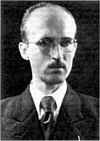
|
Yaroslav Stetsko 1912–1986 |
30 June 1941 | 9 July 1941 | Organization of Ukrainian Nationalists | |
Presidents of the UPR in exile (1948–1992)
[edit]In Munich during 1948–1992, and in New York City in 1992:
| No. | Picture | Name (Birth–Death) |
Began office | Left office | Party |
|---|---|---|---|---|---|
| 1 | 
|
Andriy Livytskyi (1879–1954) |
16 July 1948 | 17 January 1954 | Ukrainian Social Democratic Labour Party |
| 2 | 
|
Stepan Vytvytskyi (1884–1965) |
17 January 1954 | 9 October 1965 | Independent |
| 3 | 
|
Mykola Livytskyi (1907–1989) |
9 October 1965 | 8 December 1989 | Independent |
| 4 | 
|
Mykola Plaviuk (1925–2012) |
8 December 1989 | 22 August 1992 | Organization of Ukrainian Nationalists |
Presidents of modern Ukraine
[edit]On 5 July 1991, the Supreme Soviet of the Ukrainian SSR passed a law establishing the post of the "President of the Ukrainian SSR". The title was changed to "President of Ukraine" upon the proclamation of independence on 24 August 1991, simultaneously making then-Speaker of the parliament Leonid Kravchuk acting president.
The first presidential election in Ukraine was held on 1 December 1991. On 22 August 1992, the last President of the Ukrainian People's Republic in exile Mykolva Plaviuk transferred his authorities to the first post-Soviet president Leonid Kravchuk.
Non-partisan, without support or independent People's Union "Our Ukraine" Party of Regions All-Ukrainian Union "Fatherland" Petro Poroshenko Bloc "Solidarity" Servant of the People
| № | President | Took office | Left office | Elected | Party | |
|---|---|---|---|---|---|---|
| — | 
|
Leonid Kravchuk (1934–2022) |
24 August 1991 | 5 December 1991 | —[a] | Independent |
| 1 | 5 December 1991 | 19 July 1994 | 1991 | |||
| 2 | 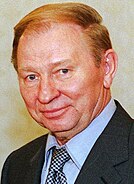
|
Leonid Kuchma (Born 1938) |
19 July 1994 | 23 January 2005 | 1994 1999 |
Independent |
| 3 | 
|
Viktor Yushchenko (Born 1954) |
23 January 2005 | 25 February 2010 | 2004 | Our Ukraine |
| 4 | 
|
Viktor Yanukovych (Born 1950) |
25 February 2010 | 22 February 2014 | 2010 | Party of Regions |
| — | 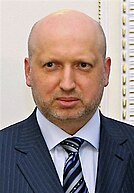
|
Oleksandr Turchynov (Born 1964) |
23 February 2014 | 7 June 2014 | —[b] | Fatherland |
| 5 | 
|
Petro Poroshenko (Born 1965) |
7 June 2014 | 20 May 2019 | 2014 | Petro Porshenko Bloc |
| 6 | 
|
Volodymyr Zelenskyy (Born 1978) |
20 May 2019 | Incumbent | 2019 | Servant of the People |
- ^ Acting President as then-Chairman of the Verkhovna Rada between the proclamation of independence and the first presidential election.
- ^ Acting President after the 2014 Revolution of Dignity and the subsequent flight of Viktor Yanukovych to Russia.
Timeline
[edit]
See also
[edit]References
[edit]- ^ "Nordiska furstar lade grunden till Ryssland". historiskamedia.se.[permanent dead link]
- ^ Suszko, Henryk (2003). Latopis hustyński. Opracowanie, przekład i komentarze. Slavica Wratislaviensia CXXIV. Wydawnictwo Uniwersytetu Wrocławskiego. ISBN 83-229-2412-7; Tolochko, Oleksiy (2010). The Hustyn' Chronicle. (Harvard Library of Early Ukrainian Literature: Texts). ISBN 978-1-932650-03-7
- ^ "Riuryk of Novgorod". www.encyclopediaofukraine.com. Retrieved 27 June 2020.
- ^ For simplifying the matter, only the most important parts of Ukrainian Kievan Rus will appear.
- ^ "Sveerne". www.fortidensjelling.dk.
- ^ Олександр Палій (2015). Історія України: Посібник. Yuri Marchenko. p. 105. ISBN 978-617-684-099-2.
- ^ Leszek Moczulski, Narodziny Międzymorza, p.475, Bellona SA, Warszawa 2007 ISBN 978-83-11-10826-4
- ^ Vladimir Plougin: Russian Intelligence Services: The Early Years, 9th–11th Centuries, Algora Publ., 2000
- ^ History of Ukraine-Rus': From prehistory to the eleventh century, Canadian Institute of Ukrainian Studies Press, 1997
- ^ Also known as Jarisleif I. See Google books
- ^ According to A. Nazarenko. It was thought not long ago that the first wife of Sviatopolk was Barbara Komnene, a supposed daughter of Alexios I Komnenos. However, the lack of tradition of such a name in the Byzantine Empire led to doubt. Today she may be considered fictional.
- ^ Possibly identified with Yaroslav Sviatoslavich, prince of Murom. Information presented for Constantine refers to Yaroslav.
- ^ a b c Monomakh branch (Mstyslavychi) at Izbornik
- ^ In 1141–46 Volhynia was ruled by Sviatoslav Vsevolodovich. See his entry below in the table.
- ^ Л.Войтович КНЯЗІВСЬКІ ДИНАСТІЇ СХІДНОЇ ЄВРОПИ
- ^ (in Russian). 1909 – via Wikisource.
- ^ Some authors give Rurik II a two-year-reign (1210–1212), and attribute to Vsevolod the Red a second reign (1212–1215), which, in this case, would mean that Vsevolod died in 1215, and not in 1212.
- ^ a b Dimnik, Martin. The Dynasty of Chernihiv – 1146–1246.
- ^ The chroniclers neglect to reveal the identity of Yaroslav's wife, but the Lyubetskiy sinodik calls her Irene; Dimnik, Martin op. cit. 121.
- ^ Basing their observations on the evidence of the Lay of Igor's Campaign, a number of historians have suggested that her name was Evfrosinia and that she may have been Igor's second wife; on the other hand, the chronicles neither give Yaroslavna's name nor suggest that she was Igor's second wife; Dimnik, Martin op. cit. 121.
- ^ Kann, Robert A. (2010). A history of the Habsburg Empire, 1526–1918. University of California Press. ISBN 978-0-520-04206-3. OCLC 951424408.
The Habsburg policy in Galicia and Bukovyna to support the Uniate church and her educational institutions and to a lesser degree the Greek Orthodox Church for the benefit of the Ruthenian Ukrainian population cannot be classified simply as divide et impera" "the first and second generation of Ruthenian literary men under Habsburg rule served this ultimate goal of Ruthenian-Ukrainian nationalism
- ^ Subtelny, Orest (2012). Ukraine a history. Univ. of Toronto Press. ISBN 978-1-4426-0991-4. OCLC 948518600.
the populace belong to the great Ruthenian [Ukrainian] nation, whose 15 million members, of whom 2.5 million live in Galicia, all speak the same language" (1848) "the Supreme Ruthenian Council, the first modern Ukrainian political organization" "they attempted to neutralize the Supreme Ruthenian Council by forming a rival Ukrainian organization that was pro-Polish.
- ^ A history of Ukraine: the land and its peoples. 1 June 2011.
The Ruthenian club established the first permanent Ukrainian theatre anywhere and with cadres from Galicia and Dnieper Ukraine
- ^ Wilson, Andrew, 1961– author. (15 October 2015). The Ukrainians : unexpected nation. Yale University Press. ISBN 978-0-300-21965-4. OCLC 922581401.
the Ukrainians were known as 'Rusyns' or, in the English version Ruthenians
{{cite book}}:|last=has generic name (help)CS1 maint: multiple names: authors list (link) CS1 maint: numeric names: authors list (link) - ^ Новосівський, Іван М. (1970). Bukovinian Ukrainians; a historical background and their self-determination in 1918. Association of Bukovinian Ukrainians. OCLC 151305.
Rumanized Ruthenian (Ukrainian) faith and customs
- ^ "Ruthenians". www.encyclopediaofukraine.com. Retrieved 27 June 2020.
- ^ Depending on the title of the ruler it was called either principality or kingdom.
- ^ Engel, Pál (2001). The Realm of St Stephen: A History of Medieval Hungary, 895–1526. I.B. Tauris Publishers. ISBN 1-86064-061-3.
- ^ Font, Márta (1991). "II. András orosz politikája és hadjáratai [Andrew II's policy and campaigns in Rus']". Századok (in Hungarian). 125 (1–2): 107–144k. ISSN 0039-8098.
- ^ Hollý, Karol (2007). "Princess Salomea and Hungarian–Polish Relations in the Period 1214–1241" (PDF). Historický Časopis. 55 (Supplement): 5–32. ISSN 0018-2575.
- ^ До половецкого плена; Соловьёв С. М. История России с дневнейших времён
- ^ Thurston, Herbert (ed.). Butler's Lives of the Saints – September.
- ^ "История монголов Карпини. Электронная библиотека исторического факультета МГУ". www.hist.msu.ru.
- ^ "Розділ 4.1. Леонтій Войтович. Князівські династії Східної Європи". izbornyk.org.ua.
- ^ Referred as natus dux et dominus Russiae
- ^ Pavlo Teteria, Hetman of the Right-bank Ukraine. Cossack leaders of Ukraine (textbook).
- ^ Lohvyn, Yu. Pavlo Teteria. Hetmans of Ukraine. "Merry Alphabet".
- ^ Pavlo Teteria. History of the Great Nation.
- ^ a b Horobets, V. Civil wars in Ukraine of 1650s-1660s. Encyclopedia of history of Ukraine. Vol.2. Kyiv: "Naukova Dumka", 2004.
- ^ March 28 – The meeting of the Ukrainian Central Council, first chaired by Mykhailo Hrushevsky


